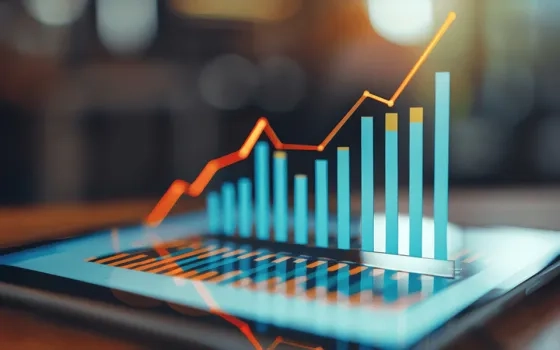In the late 1950s, Professor Charles David Keeling, a geochemist, installed a couple of machines on top of Mauna Loa, a volcano in Hawaii, to measure atmospheric carbon. Fossil fuel consumption had started to increase and there was a suggested link between atmospheric carbon and the burning of fossil fuels. Charles Keeling was the first scientist to figure out an accurate way to measure its levels. More importantly, Charles Keeling doggedly fought to keep those machines running and thanks to those efforts, we have accurate readings of atmospheric carbon for the last several decades. The resultant, The Keeling Curve, is one the most important and un-disputed barometers of what the economy and human intervention has done to our world. Over the last 50 years, atmospheric carbon has increased by approximately 143% to approximately 36 billion metric tons.
Developed countries achieved their growth by rapidly increasing their industrial output linearly, but at the same time increased carbon emission and environmental pollution. Take for example, the per capita emission of carbon dioxide - the United States, Canada, and Australia average around 15-16 metric tons, China is at 7 metric tons and India is close to 2.
While we have lived through decades of technological revolution, economic activity has been increasingly biased towards increasing consumption and reducing or eliminating re-use ; a “use and throw” paradigm and a world of instant gratification, where speed and convenience trumps all other objectives.
This raises one key question and one observation :
- Is the convenience worth the cost ?
- What has got us to this point will not be what will sustain us in the future.
Also, convenience breeds a certain inertia where countries become comfortable with the status quo. However, to break this cycle, the onus lies on both developed as well developing countries. Developed countries must transition to newer technologies and reduce their dependence on fossil fuel significantly and at the same time provide support to developing countries to leapfrog and adopt newer methods.
If we take India for example, over several decades we have learnt to re-use and re-purpose and extend the life of daily products ; walk into any mobile phone store and you see this in action. One source of this knowledge is through traditional based systems which emphasized a connection with nature. The other was borne out of necessity and lack of income. Human beings, by nature generally prefer the shorter and the path of least effort. So as general prosperity has increased, and disposable incomes larger, we have reverted to a more wasteful approach and hence there the deep risk for India is that as we pull more people out of poverty, we will rapidly move towards un-sustainability if we continue as-is.
And so, the implication is simple – it is imperative for India to think radically of newer and better ways of producing products and utilizing resources so that waste becomes nonexistent as much as possible. For example, Accenture in collaboration with FICCI alone estimates that half a trillion dollars of India’s GDP which can be protected via the circular economy by 2030. The World Economic Forum puts forth a saving of 1 trillion dollars per year for the world if all countries adopt a circular economy-based approach.
To be sure, India is probably one of the developing economies which has done better than most. Governmental support is critical, and the Indian Government has signalled its intent. They have identified 11 different areas to push sectoral reforms. These include waste (solid/liquid/electronic/agriculture/industrial/used oil), to recycling to managing end of life vehicles. If we take plastic waste management alone, the Government has again mandated that all plastic waste producers collect their produce by 2024. Private companies will need to do their part as well.
That said, for the circular economy approach to truly succeed in India, there are a few areas that must be addressed:
- Viability : Given that India is a highly price sensitive country, the price becomes the single determinant by which the success or failure of a method or process will be judged. To keep the price low, volumes need to be raised and this can only be done through scale. Without scale, sustainable solutions will always be viewed as more expensive and hence not chosen.
- Transition Roadmap away from fossil fuels : While India has set a target of drawing 40% of its electric power through non fossil fuels by 2040, moving away entirely from coal will be deeply challenging. This will be a disruptive move which can cause economic activity to be impeded as the risk of those employed in the coal sector could be at risk. These individuals will need to be rehabilitated, reskilled, or compensated.
- Awareness and Re-skilling / training : Germany pioneered a very successful apprenticeship model which has helped them become one of the leading industrial powerhouses of the world. This model has been codified into law and requires several organizations to work together. This model imparts practical skilling across 300+ occupations thereby improving the employability of the workforce drastically. To some extent, The Government of India has notified an apprentice program for undergraduates but many of these interventions need to begin much earlier just after high school to ensure that an individual has the right skills when they enter the formal economy.
- Creation of incentives : As India is a fast-growing economy, we will need to identify specific sectors where either the impact will be significant or those which can make a transition quickly. Accenture in collaboration with FICCI identify petroleum, plastics, cement, gold, steel, copper, fibre and textiles and gold as segments to go after. That said, there must also be a strengthening of regulations and adequate enforcement. Without a supporting ecosystem, any transition will be impossible. Strong structural incentives for all involved parties would help move things along. Also, start-ups investing in new technology or have innovative solutions must be supported through meaningful grants. The World Economic Forum’s Circulars Accelerators is one example of how this may be achieved.
- Digitization of supply chains : If we take food waste alone, annually, it is estimated that over 1.3 billion tons of food in the world are wasted per year and by 2030, this number is expected to rise to 2.1 billion tons. In one way, the lack of large-scale digital supply chains may help India in that it could help the country leapfrog and put into place systems that provide traceability and visibility across the lifecycle.
For India, even incremental changes can cause disproportionate changes given its size and scale. While India ranks as one of the highest plastic recyclers in the world with 60% of its plastic being recycled, approximately 40% continues to be sent to landfills and so the task at hand is mammoth. That said, developed countries should not shirk their responsibility ; there must be adequate pressure to ensure that the meet their commitments, transition and help developing countries adopt new technologies. India should control and change what it can within its sphere of influence. Change is inherently difficult, and the easiest response is one of resistance. But it is the only way forward and we need to take a long-term view and dispense with jugaad solutions. Otherwise, future generations will have to bear the effects of our inaction.
Sources
- Accelerating India’s Circular Economy Shift – FICCI and Accenture (2018)
- An Inclusive Circular Economy: Priorities for Developing Countries, India – Chatham House (2021)
- Fighting Food Waste using the Circular Economy – KPMG Australia (2020)
- Steps toward a resilient circular economy in India – Joseph Fiksel, Praveena Sanjay & Kavya Raman, Clean Technologies and Environmental Policy (2021)
- Govt Driving Transition from Linear to Circular Economy – NITI Aayog (2021)
- CO2 emissions – Our World in Data (Updated 2020)
- Plastic waste recycling targets ; PPP mode for recycling – theprint.in (2021)
- German Dual Apprenticeship Program – expatrio.com (2021)
- Circular Accelerators (https://thecirculars.org/)
- India targeting 40% of power generation from non-fossil fuel by 2030 (PM Modi) – ET India (2021)
About the author:

Ravishankar Rao (Director – Strategy and Operations, Cisco Engineering India)
Views are personal
Photo Credit : Photo by Josh Power on Unsplash

















